- [LIB-2830.2021] Raymond Radiguet. Vers libres / [Illustrés par Rojan]. — Champigny: Au Panier Fleuri [i.e. Paris, René Bonnel, c. 1935].
- [LIB-2827.2021] Raymond Radiguet. Vers libres / Illustrés par Rojan. — Nogent: Au Panier Fleuri [i.e. Paris, c. 1937].
-
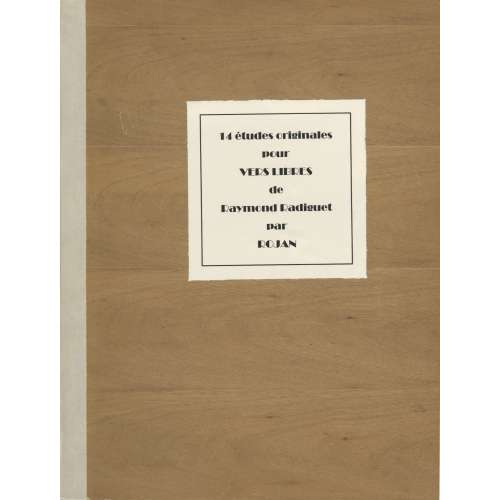 Portfolio of 14 original watercolour illustrations for Vers Libres by Raymond Radiguet. Painted on wove paper of different sizes, each mounted in a passe-partout 39,5 x 33 cm and enclosed in a flapped portfolio with a white label to front cover lettered "14 études originales | pour | VERS LIBRES | de | Raymond Radiguet | par | ROJAN". For published versions, see:
Portfolio of 14 original watercolour illustrations for Vers Libres by Raymond Radiguet. Painted on wove paper of different sizes, each mounted in a passe-partout 39,5 x 33 cm and enclosed in a flapped portfolio with a white label to front cover lettered "14 études originales | pour | VERS LIBRES | de | Raymond Radiguet | par | ROJAN". For published versions, see: -
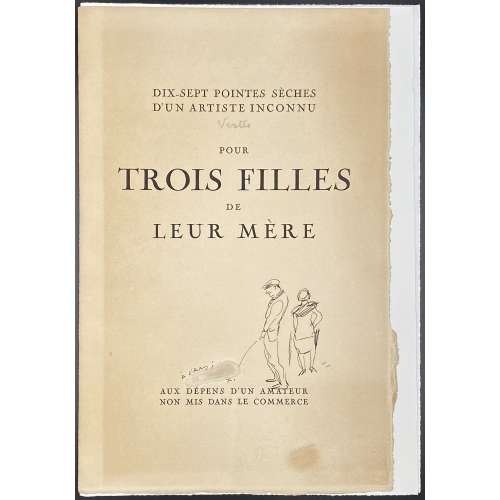 Seventeen drypoint prints in purple plus one original ink sketch by Marcel Vertés (French, 1895 – 1961) – illustrations to the book by Pierre Louÿs Trois filles de leur mère, in a paper folder. Front : DIX-SEPT POINTES SÈCHES | D'UN ARTISTE INCONNU | POUR | TROIS FILLES | DE | LEUR MÈRE | {space} | AUX DÉPENS D'UN AMATEUR | NON MIS DANS LE COMMERCE || Pencil manuscript Vertés under “ARTISTE”, autograph vignette above “AMATEUR”, erased dedication inscription above “DÉPENS” À L’AMI [erased] X. Back: JUSTIFICATION DU TIRAGE | 17 EXEMPLAIRES SUR VÉLIN D’ARCHES CONTENANT | UNE SUITE DES DIX-SEPT POINTES SÈCHES EN | NOIR : UNE SUITE EN COULEURS COLORIÉE PAR | L’ARTISTE ; UN DESSIN ORIGINAL ET SA PLANCHE | DE CUIVRE ; DIX-SEPT CROQUIS ORIGINAUX | MARQUÉS A à Q. | 50 EXEMPLAIRES SUR VÉLIN D’ARCHES CONTE- | NANT UNE SUITE DES DIX-SEPT POINTES | SÈCHES ET TROIS CROQUIS ORIGINAUX | NUMÉROTÉS DE 1 à 50. | {space} | EXEMPLAIRE № {by hand} H. C. || Size : folder 28 x 17.5 cm; sketch 26.6 x 17.6 cm; prints 27.5 x 19 cm. Printed on wove paper with MBM watermark (Arches MBM Paper). Bookplate pasted to the makeshift extra folder with title: “EX-LIBRIS | Jacques | Crepineau”. Provenance: Jacques Crepineau (French, 1932 – 2017). Description by seller: [CURIOSA - VERTÈS (Marcel)]. Dix-sept pointes sèches d'un artiste inconnu pour Trois filles de leur mère. S.l. : Aux dépens d'un amateur, [1927]. — In-8, en feuilles. Dutel 2517*. Rare suite de 17 pointes-sèches libres réalisées par Marcel VERTÈS, probablement publiée par Marcel Cotinaud. Elle était destinée à accompagner l'édition originale de Trois filles de leur mère de Pierre Louÿs publiée un an plus tôt. Tirage à 67 exemplaires sur vélin d'Arches. Les épreuves sont tirées en violet. Exemplaire sans le feuillet de titre, ni celui de la justification. Il comprend un croquis original de l'artiste, non signé, ayant servi d'étude pour l'une des planches. Selon les tirages, chaque exemplaire devrait comprendre 17 croquis pour les 17 premiers, ou 3 pour les 50 autres, non n'en avons ici qu'un seul. Envoi de Vertès sur la couverture, accompagné d'un dessin original. Le nom du destinataire a été effacé. Manque la chemise et l'étui. Description by DUTEL v.3, p. 389, № 2517: In-4 (28 x 19) de 2 ff., 17 pointes sèches, étui, chemise. … publiée en 1927 probablement par Marcel Cotinaud (SV : publisher of Vertés was Paul Cotinaud)… Les planches sont tirées en violet (SV : like this one). Tirage : 17 ex. …avec une suite coloriée par l’artiste, un dessin, un cuivre et 17 croquis. 50 ex. … avec 3 croquis. Other names: Marcel Vertès, Marcel Vertes, Marcell Vértes
Seventeen drypoint prints in purple plus one original ink sketch by Marcel Vertés (French, 1895 – 1961) – illustrations to the book by Pierre Louÿs Trois filles de leur mère, in a paper folder. Front : DIX-SEPT POINTES SÈCHES | D'UN ARTISTE INCONNU | POUR | TROIS FILLES | DE | LEUR MÈRE | {space} | AUX DÉPENS D'UN AMATEUR | NON MIS DANS LE COMMERCE || Pencil manuscript Vertés under “ARTISTE”, autograph vignette above “AMATEUR”, erased dedication inscription above “DÉPENS” À L’AMI [erased] X. Back: JUSTIFICATION DU TIRAGE | 17 EXEMPLAIRES SUR VÉLIN D’ARCHES CONTENANT | UNE SUITE DES DIX-SEPT POINTES SÈCHES EN | NOIR : UNE SUITE EN COULEURS COLORIÉE PAR | L’ARTISTE ; UN DESSIN ORIGINAL ET SA PLANCHE | DE CUIVRE ; DIX-SEPT CROQUIS ORIGINAUX | MARQUÉS A à Q. | 50 EXEMPLAIRES SUR VÉLIN D’ARCHES CONTE- | NANT UNE SUITE DES DIX-SEPT POINTES | SÈCHES ET TROIS CROQUIS ORIGINAUX | NUMÉROTÉS DE 1 à 50. | {space} | EXEMPLAIRE № {by hand} H. C. || Size : folder 28 x 17.5 cm; sketch 26.6 x 17.6 cm; prints 27.5 x 19 cm. Printed on wove paper with MBM watermark (Arches MBM Paper). Bookplate pasted to the makeshift extra folder with title: “EX-LIBRIS | Jacques | Crepineau”. Provenance: Jacques Crepineau (French, 1932 – 2017). Description by seller: [CURIOSA - VERTÈS (Marcel)]. Dix-sept pointes sèches d'un artiste inconnu pour Trois filles de leur mère. S.l. : Aux dépens d'un amateur, [1927]. — In-8, en feuilles. Dutel 2517*. Rare suite de 17 pointes-sèches libres réalisées par Marcel VERTÈS, probablement publiée par Marcel Cotinaud. Elle était destinée à accompagner l'édition originale de Trois filles de leur mère de Pierre Louÿs publiée un an plus tôt. Tirage à 67 exemplaires sur vélin d'Arches. Les épreuves sont tirées en violet. Exemplaire sans le feuillet de titre, ni celui de la justification. Il comprend un croquis original de l'artiste, non signé, ayant servi d'étude pour l'une des planches. Selon les tirages, chaque exemplaire devrait comprendre 17 croquis pour les 17 premiers, ou 3 pour les 50 autres, non n'en avons ici qu'un seul. Envoi de Vertès sur la couverture, accompagné d'un dessin original. Le nom du destinataire a été effacé. Manque la chemise et l'étui. Description by DUTEL v.3, p. 389, № 2517: In-4 (28 x 19) de 2 ff., 17 pointes sèches, étui, chemise. … publiée en 1927 probablement par Marcel Cotinaud (SV : publisher of Vertés was Paul Cotinaud)… Les planches sont tirées en violet (SV : like this one). Tirage : 17 ex. …avec une suite coloriée par l’artiste, un dessin, un cuivre et 17 croquis. 50 ex. … avec 3 croquis. Other names: Marcel Vertès, Marcel Vertes, Marcell Vértes -
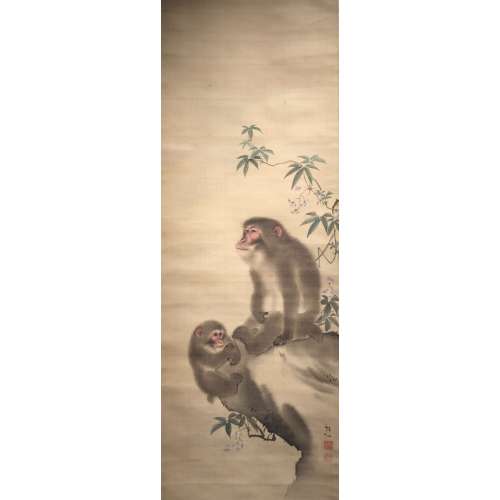 Mori Sosen (1747-1821). A Monkey Seated on a Rock with an Infant Monkey. Hanging scroll painting. Ink and colour on silk. Signed: Sosen. Sealed: Sosen. 108.3 x 38.3 cm. Provenance: According to the box inscriptions, the painting was in the possession of Itakura Katsunao, a daimyo lord in present-day Gunma, in 1808. In 1881, the painting was subsequently acquired by Negishi Shôrei (1833-1897) a master swordsman who established the Negishi school of shuriken ("The only specialist school to have survived is the Negishi-ryū, which was founded by Negishi Shorei in the mid-1800s".)
Mori Sosen (1747-1821). A Monkey Seated on a Rock with an Infant Monkey. Hanging scroll painting. Ink and colour on silk. Signed: Sosen. Sealed: Sosen. 108.3 x 38.3 cm. Provenance: According to the box inscriptions, the painting was in the possession of Itakura Katsunao, a daimyo lord in present-day Gunma, in 1808. In 1881, the painting was subsequently acquired by Negishi Shôrei (1833-1897) a master swordsman who established the Negishi school of shuriken ("The only specialist school to have survived is the Negishi-ryū, which was founded by Negishi Shorei in the mid-1800s".) -
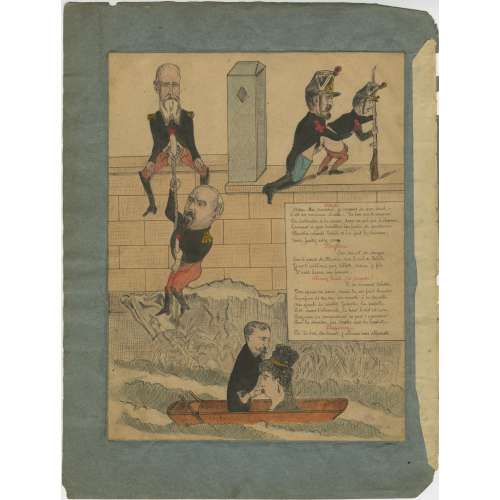 A series of seven political caricatures with indecent content, ink and pigment on paper, bound in a grey-blue folder. Each drawing is pasted to a grey-blue sheet of paper 32 x 24 cm. PLATES: 1) Villette; Bazaine; Alvarez Rull: 250 x 192 mm
A series of seven political caricatures with indecent content, ink and pigment on paper, bound in a grey-blue folder. Each drawing is pasted to a grey-blue sheet of paper 32 x 24 cm. PLATES: 1) Villette; Bazaine; Alvarez Rull: 250 x 192 mm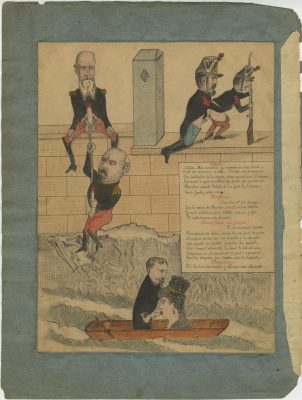
Villette Adieu, cher maréchal, je réponds de mon dard C’est un morceau d’acier… Là bas, sur le rempart, Sa cartouche à la main, dans un cul qui le charme, Lançant à gros bouillons son foutre de gendarme Plantin plante Delille et lui font le Caisson. Bazaine Sur ton vit de dragon Sur le nœud de Plantin, sur le cul de Delille, Je ne t’oublierai pas, Villette, adieu, je file Et je vais baiser ma femme. Alvarez Rull (à Josépha) Il ne saurait tarder, Ton epoux va venir, mais tu me fais bander, Le parfum de ton con me monte à la cervelle, Ma gaule se raidit . Josépha, la nacelle Est dans l’ obscurité, là haut, le ciel est noir, Bazaine en descendant ne peut t’ apercevoir … Pour la dernière fois, torche moi la houlette. Bazaine Eh ! là bas, du canot, j’allume une allumette!
Villette Farewell, dear Marshal, I vouch for my dick. It’s like a steel rod … Over there, on the ramparts, Plantin, his dick in hand, pounds Delisle’s beckoning ass And fills it with his bubbling gendarme’s cum. Bazaine For your dragoon’s dick, For Plantin's prick, for Delisle's ass, I won't forget you, Villette, goodbye, I'm leaving And I'm going to fuck my wife. Alvarez Rull (to Josépha) Hurry up, Your husband is coming, but I got a hard on you, The scent of your cunt penetrates my brain, My rod stiffened. Josépha, the gondola Is in the dark, the sky is black, Bazaine coming down and cannot see you... Give me one last blowjob.Bazaine Hey! Over there, from the canoe, I light a match!
French marshal Achille Bazaine capitulated to Bismarck during the Franco-Prussian war on 27 October 1870. In 1873, he was tried for treason and received a death sentence, later commuted to 20 years' imprisonment. Bazaine was incarcerated in the Fort Royal on Île Sainte-Marguerite, from which he escaped on August 9–10, 1874, with the help of Colonel Villette [Willette], his wife Josefa [Pepita Peña], and her nephew Alvarez Rull. They sailed to Genoa in Italy and from there to London. Plantin and Delisle were prison guards. The story was described in detail during the Trial of Col. Villette and his Accomplices in 1874 and published later in Robert Christophe. La Vie tragique du maréchal Bazaine. — Paris: Vautrain Jacques, 1947.
2) Impératrice Eugénie: 218 x 165 mm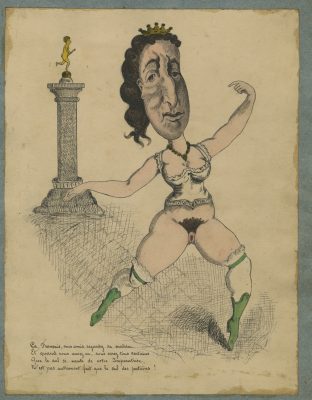
Ça, Français, mes amis, regardez sa matrice, Et quand vous aurez vu, vous serez tous certains Que le cul si vanté de votre Impératrice, N’est pas autrement fait que le cul des putains!
That, French, my friends, look at her cunt, And when you have seen, you will all be certain That the so acclaimed ass of your Empress, Is no different than the ass of whores! 3) Napoléon III: 215 x 168 mm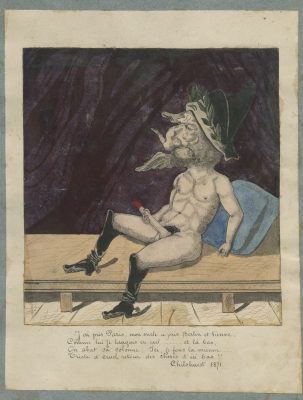
J’ai pris Paris, mon oncle a pris Berlin et Vienne. Comme lui je languis en exil …… et là bas, On abat sa colonne; Ici, je fous la mienne…. Triste et cruel retour des choses d’ici bas!! Chilshurst 1871. [i.e. Chislehurst]
I took Paris, my uncle took Berlin and Vienna. Like him, I, too, languish in exile. His column there was demolished; I’m jerking mine off here…. Cruel and sorrowful deeds!! 4) La confession: 216 x 168 mm (Georges Darboy?)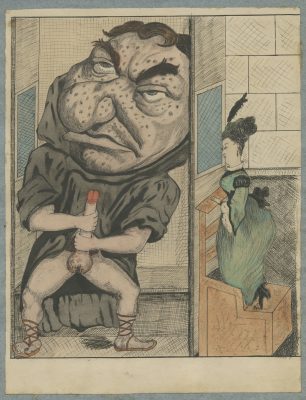 5) Napoléon III et Thérèsa (chanteuse Désirée Emma Valladon): 216 x 176 mm
5) Napoléon III et Thérèsa (chanteuse Désirée Emma Valladon): 216 x 176 mm
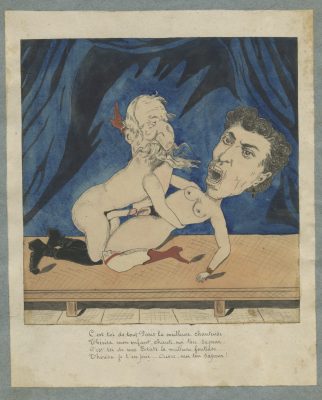
C’est toi de tout Paris la meilleure chanteuse, Thérèsa mon enfant, chante-moi ton sapeur. C’est toi de mes Etats la meilleure fonteuse.. Thérèsa je t’en prie … Ouvre-moi ton sapeur!
You, the best singer in all of Paris, Teresa, my child, sing for me where to insert. You are the best padding in my entire country… Teresa, please... Open your slit for me! 6) Thiers: 219 x 168 mm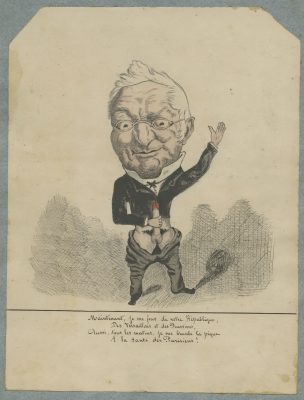
Maintenant, je me fous de votre République, Des Versaillais et des Prussiens, Aussi, tous les matins, je me branle la pique A la santé des Parisiens!
Yes, I don’t care about your Republic now, About Versailles and the Prussians, And every morning I jerk off For the health of Parisians! 7) Émile Ollivier/Rochefort/Jules Favre/Gambetta : 212 x 168 mm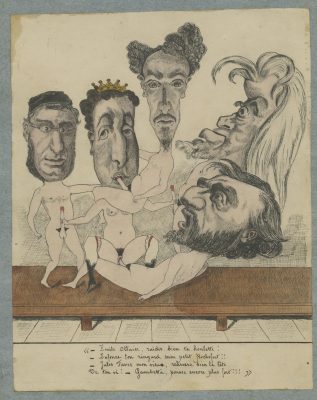
« — Emile Ollivier, raidis bien la houlette! — Enfonce ton ringard mon petit Rochefort!! — Jules Favre mon vieux, redresse bien la tête De ton vi! — Gambetta, pousse encore plus fort!!! »
Emile Ollivier, tighten your dick! - Stick in your poker, my little Rochefort!! - Jules Favre, old man, straighten your dickhead Damn it! – Gambetta, push even harder!!!Characters: Bazaine, François Achille (French, 1811 – 1888) Darboy, Georges (French, 1813 – 1871) Favre, Jules (French, 1809 – 1880) Gambetta, Léon (French, 1838 – 1882) Montijo, Eugénie de (Spanish-French, 1826 – 1920) Napoleon III [Bonaparte, Charles-Louis Napoléon] (French, 1808 – 1873) Ollivier, Émile (French, 1825 – 1913) Peña Azcárate, Josefa [Peña, Pepita] (Mexican-French, 1847 – 1900); Alvarez Rull – nephew of Josefa Peña Azcárate. Rochefort, Henri (French, 1831 – 1913) Thérésa [Valladon, Désirée Emma] (French, 1836 – 1913) Thiers, Adolphe (French, 1797 – 1877)
-
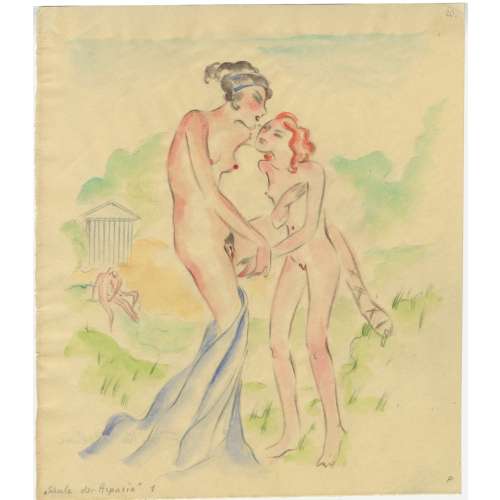 NEWPencil and watercolour on paper 230 x 197 mm, pencil ms inscription in the bottom-left “Schule der Aspasia” 1 (2, 3), monogrammed “P” in the bottom-right, and “Erika Plehn” to verso. Apparently, illustrations for ‘Die Weisheiten der Aspasia’ also known as ‘Die Dirnenschule der Aspasia’ (Aspasia's prostitute school), an erotic novel by Fritz Thurn (Foregger), privately published in Vienna in 1923. Artist: Erika Plehn [née Erika Pinkus] (German, 1904 – 1988) Author: Fritz Thurn [Foregger zum Greiffenthurn] (Austrian, 1877 – 1938). Aspasia of Miletus (Greek, c. 464 BCE – c. 420 BCE)
NEWPencil and watercolour on paper 230 x 197 mm, pencil ms inscription in the bottom-left “Schule der Aspasia” 1 (2, 3), monogrammed “P” in the bottom-right, and “Erika Plehn” to verso. Apparently, illustrations for ‘Die Weisheiten der Aspasia’ also known as ‘Die Dirnenschule der Aspasia’ (Aspasia's prostitute school), an erotic novel by Fritz Thurn (Foregger), privately published in Vienna in 1923. Artist: Erika Plehn [née Erika Pinkus] (German, 1904 – 1988) Author: Fritz Thurn [Foregger zum Greiffenthurn] (Austrian, 1877 – 1938). Aspasia of Miletus (Greek, c. 464 BCE – c. 420 BCE) -
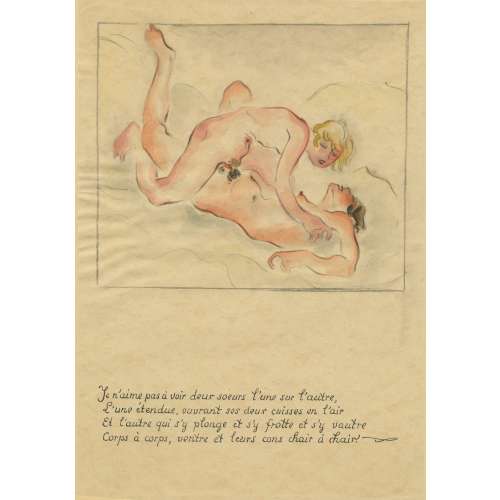 NEWFramed pencil and watercolour drawings with 4-line manuscript pen and ink French text under the frame on paper 255 x 175 mm mounted on card stock sheets 290 x 210 mm. Illustrations correspond to the 1st edition of Pierre Louÿs’ « Pybrac / Poésies » published by Cythère Au coq hardi in 1927 [LIB-3061.2022], pp. 25, 37, 64, 69, 85, 86, and 94. Illustrations here are placed in the order they would have appeared in the book.
NEWFramed pencil and watercolour drawings with 4-line manuscript pen and ink French text under the frame on paper 255 x 175 mm mounted on card stock sheets 290 x 210 mm. Illustrations correspond to the 1st edition of Pierre Louÿs’ « Pybrac / Poésies » published by Cythère Au coq hardi in 1927 [LIB-3061.2022], pp. 25, 37, 64, 69, 85, 86, and 94. Illustrations here are placed in the order they would have appeared in the book.- Je n’aime pas à voir deux sœurs l’une sur l’autre, L’une étendue, ouvrant ses deux cuisses en l’air, Et l’autre qui s’y plonge et s’y frotte et s’y vautre, Corps à corps, ventre à ventre et leurs cons chair à chair.
- Je n’aime pas à voir la douce concubine Qu’on encule toujours et qui, d’un doigt lascif Se branle le bouton, se tire la barbiche, Pour soulager son cul douloureux et passif
- Je n’aime pas à voir cette Sappho mascule Qui, dans sa chambre, habille une fille en garçon, Lui baisse la culotte et froidement l’encule Avec un godmiché plus gros qu’un saucisson.
- Je n’aime pas à voir la vierge au doigt lubrique Qui, les deux pieds en l’air, masturbe sur le lit Son pucelage en rut, gonflé, couleur de brique, Et décharge en baisant le roman qu’elle lit.
- Je n’aime pas à voir le garçon sur la fille Donner des coups au cul et danser le galop Aux applaudissements de toute la famille Qui dit : « Ça vient, putain ! Fais-la jouir, salop ! »
- Je n’aime pas à voir la princesse de Grèce, Qui, menée au bordel par sa fille d’honneur, Frotte sa bouche obscène au cul de la négresse Et crie en déchargeant : « C’est là qu’est le bonheur ! »
- Je n’aime pas à voir dans un bal de familles Que l’hôtesse dispose une chambre d’ami Et des lits de repos, au gré des jeunes filles, Pour sucer leurs danseurs ou se faire mimi.
-
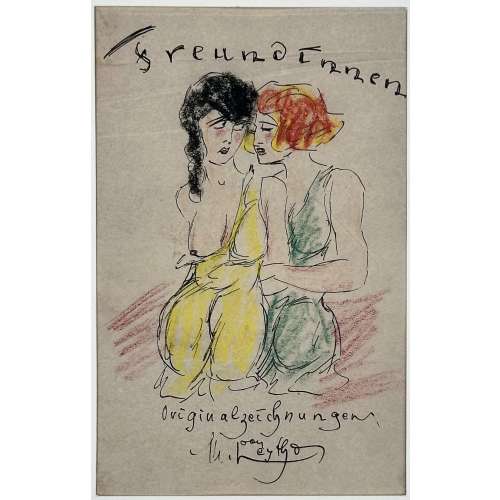 Seven pen and ink and colour crayon drawings on thin wove paper approx. 140 x 100 mm, each attached to a sheet 310 x 240 mm and mounted in a passepartout, placed in an aubergine cardboard folder 310 x 250 mm with a tan vellum spine and paper flaps inside; olive label with double border and gilt lettering to front cover "Dessins" [Drawings]. The first sheet is a title-page lettered in manuscript: Freundinnen | {vignette} | Originalzeichnungen | M. Leytho || [Girlfriends. Original drawings]. Information about the artist at www.honesterotica.com: "Mitja Leytho, almost certainly a pseudonym, is yet another mediocre yet fascinating amateur artist from the Germany of the 1920s about whom we know absolutely nothing beyond the four portfolios which bear the ‘Leytho’ signature". We shall notice that this set of drawings was produced by a talented professional, not an amateur.
Seven pen and ink and colour crayon drawings on thin wove paper approx. 140 x 100 mm, each attached to a sheet 310 x 240 mm and mounted in a passepartout, placed in an aubergine cardboard folder 310 x 250 mm with a tan vellum spine and paper flaps inside; olive label with double border and gilt lettering to front cover "Dessins" [Drawings]. The first sheet is a title-page lettered in manuscript: Freundinnen | {vignette} | Originalzeichnungen | M. Leytho || [Girlfriends. Original drawings]. Information about the artist at www.honesterotica.com: "Mitja Leytho, almost certainly a pseudonym, is yet another mediocre yet fascinating amateur artist from the Germany of the 1920s about whom we know absolutely nothing beyond the four portfolios which bear the ‘Leytho’ signature". We shall notice that this set of drawings was produced by a talented professional, not an amateur. -
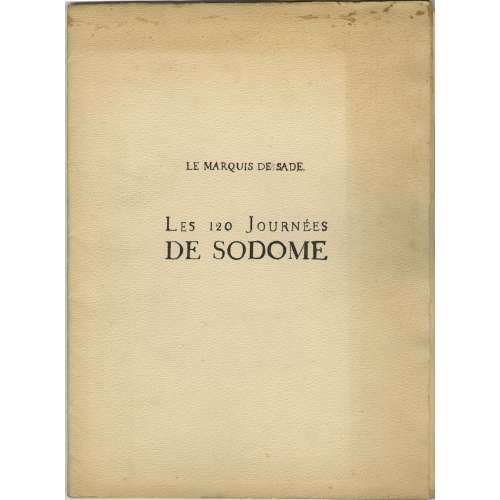 A set of sixteen pen and ink wash drawings on wove paper by an anonymous artist after lithographs by André Collot, who illustrated the 1935 edition of Les 120 journées de Sodome, ou l’école du libertinage, by the Marquis de Sade, based on the original autograph manuscript by Maurice Heine. The set is housed in a rough texture paper folder with an ink manuscript to the front: LE MARQUIS DE SADE. | Les 120 journées | DE SODOME || Size: 340 x 250 mm (folder); 335 x 252 (sheet); approx. 160 x 110 (image). Contributors: Donatien Alphonse François, Marquis de Sade (French, 1740 – 1814) – author. Maurice Heine (French, 1884 – 1940) – publisher of the original Les 120 journées. André Collot (French, 1897-1976) – artist of the original illustrations for the 1935 edition. This set was produced by an anonymous artist from the bohemian Montmartre, Montparnasse, or the School of Fine Arts, close to the booksellers', by demand of an excentric bibliophile, at about the same time. Collot's illustrations can be found at www.honesterotica.com.
A set of sixteen pen and ink wash drawings on wove paper by an anonymous artist after lithographs by André Collot, who illustrated the 1935 edition of Les 120 journées de Sodome, ou l’école du libertinage, by the Marquis de Sade, based on the original autograph manuscript by Maurice Heine. The set is housed in a rough texture paper folder with an ink manuscript to the front: LE MARQUIS DE SADE. | Les 120 journées | DE SODOME || Size: 340 x 250 mm (folder); 335 x 252 (sheet); approx. 160 x 110 (image). Contributors: Donatien Alphonse François, Marquis de Sade (French, 1740 – 1814) – author. Maurice Heine (French, 1884 – 1940) – publisher of the original Les 120 journées. André Collot (French, 1897-1976) – artist of the original illustrations for the 1935 edition. This set was produced by an anonymous artist from the bohemian Montmartre, Montparnasse, or the School of Fine Arts, close to the booksellers', by demand of an excentric bibliophile, at about the same time. Collot's illustrations can be found at www.honesterotica.com. -
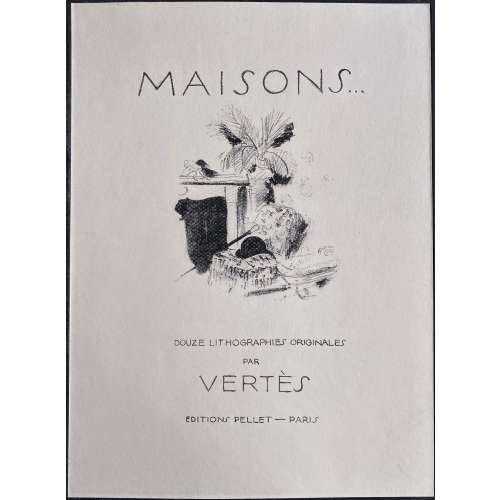 Album in-folio of 13 lithographs by Marcel Vertès, incl. title-page, each in a passe-partout 41.5 x 31.7 cm with 33.0 x 23.0 cm window, printed on wove paper sheets 38.0 x 28.0 cm and crayon-coloured by the artist; graphite pencil drawings by Marcel Vertès on the lower-right corner of each passe-partout; all in a buckram-backed flapped folder, signed ‘AT BOICHOT’, with an uncoloured title-page lithograph on front cover. Edition limited to 100 copies on Chine (№№ 1-100) and 900 on Vélin (№№ 1 to 900); this is a copy № 22 (Vélin), unique as enhanced by the artist. Double-folio leaf 41 x 31 cm with text by Pierre Mac-Orlan. These lithographs, uncoloured, were used in Pierre Mac-Orlan. Les jeux du demi-jour / avec douze lithographies de Vertès. — Paris: Les arts et le livre, 1926 [LIB-2893.2021]. Lithographed title-page: MAISONS.... | {vignette} | DOUZE LITHOGRAPHIES ORIGINALES | PAR | VERTÈS | ÉDITIONS PELLET ~ PARIS || Catalogue raisonné: Vokaer: № 5, p. 7; Nordmann (1): 423, p. 267. Contributors: Pierre Mac-Orlan (French, 1882 – 1970) – author. Marcel Vertès [Marcell Vértes] (Jewish-Hungarian-French, 1895 – 1961) – artist. Gustave Pellet (1859 – 1919) – publisher. Thomas Boichot – bookbinder. Description by J.-P. Dutel: MAC ORLAN Pierre. VERTES Marcel. MAISONS... Douze lithographies originales. Paris, Editions Pellet, [1925]. In-folio (410 x 310 mm) de [4] ff. et 13 lithographies sous passe-partout dont un titre. Chemise en demi-soienoire, premier plat illustré de la même lithographie que celle utilisée pour le titre (AT Boichot). TIRAGE : 100 albums sur chine avant la signature gravée, chaque planche signée. 900 albums sur vélin. :Un des 900 albums sur vélin (n° 22). EXEMPLAIRE UNIQUE DANS LEQUEL LES 13 LITHOGRAPHIES ONT ÉTÉCOLORIÉES AUX CRAYONS DE COULEURS PAR VERTÈS. DE PLUS, CHAQUE PASSE-PARTOUT COMPORTE EN BAS À DROITE UN CROQUIS ORIGINAL À LA MINE DE PLOMB CORRESPONDANT À UNE VERSION PLUS LIBRE DELA LITHO.
Album in-folio of 13 lithographs by Marcel Vertès, incl. title-page, each in a passe-partout 41.5 x 31.7 cm with 33.0 x 23.0 cm window, printed on wove paper sheets 38.0 x 28.0 cm and crayon-coloured by the artist; graphite pencil drawings by Marcel Vertès on the lower-right corner of each passe-partout; all in a buckram-backed flapped folder, signed ‘AT BOICHOT’, with an uncoloured title-page lithograph on front cover. Edition limited to 100 copies on Chine (№№ 1-100) and 900 on Vélin (№№ 1 to 900); this is a copy № 22 (Vélin), unique as enhanced by the artist. Double-folio leaf 41 x 31 cm with text by Pierre Mac-Orlan. These lithographs, uncoloured, were used in Pierre Mac-Orlan. Les jeux du demi-jour / avec douze lithographies de Vertès. — Paris: Les arts et le livre, 1926 [LIB-2893.2021]. Lithographed title-page: MAISONS.... | {vignette} | DOUZE LITHOGRAPHIES ORIGINALES | PAR | VERTÈS | ÉDITIONS PELLET ~ PARIS || Catalogue raisonné: Vokaer: № 5, p. 7; Nordmann (1): 423, p. 267. Contributors: Pierre Mac-Orlan (French, 1882 – 1970) – author. Marcel Vertès [Marcell Vértes] (Jewish-Hungarian-French, 1895 – 1961) – artist. Gustave Pellet (1859 – 1919) – publisher. Thomas Boichot – bookbinder. Description by J.-P. Dutel: MAC ORLAN Pierre. VERTES Marcel. MAISONS... Douze lithographies originales. Paris, Editions Pellet, [1925]. In-folio (410 x 310 mm) de [4] ff. et 13 lithographies sous passe-partout dont un titre. Chemise en demi-soienoire, premier plat illustré de la même lithographie que celle utilisée pour le titre (AT Boichot). TIRAGE : 100 albums sur chine avant la signature gravée, chaque planche signée. 900 albums sur vélin. :Un des 900 albums sur vélin (n° 22). EXEMPLAIRE UNIQUE DANS LEQUEL LES 13 LITHOGRAPHIES ONT ÉTÉCOLORIÉES AUX CRAYONS DE COULEURS PAR VERTÈS. DE PLUS, CHAQUE PASSE-PARTOUT COMPORTE EN BAS À DROITE UN CROQUIS ORIGINAL À LA MINE DE PLOMB CORRESPONDANT À UNE VERSION PLUS LIBRE DELA LITHO. -
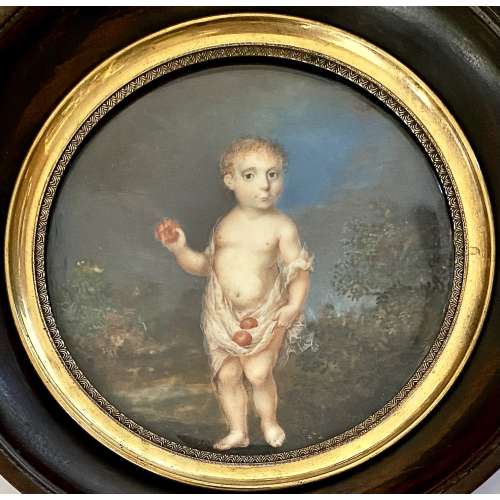 Round portrait of a little girl (22-month-old) with bright black eyes and red hair, draped in a semi-transparent shirt which leaves her chest and stomach bare, keeping a red apple in her right hand and two others lying in the fold of her clothes, standing against a dark natural background: bushes, leaves, an apple tree, blue skies, clouds, etc. Oil on metal; in an ormolu frame, in a wooden frame. Diameter without frames 8 cm, with frames – 12.6 cm. Sitter: Courtois, Fortunée-Florentine Elisabeth (French, August 23, 1800 г. – after 1878). Inscription (handwriting, nut ink): Fortunée, Florentine Elisabeth | Courtois a 22 mois. | née 5e fructidor an 8 || Attributed to Lié Louis Périn-Salbreux (French, 1753 – 1817). Fortunée-Florentine Elisabeth Courtois is a mother of Maurice Joly (French, 1829 – 1878). See also in this collection: blog, LIB-0460, blog, LIB-1038.2016, and Une Épave de l’Ancien Bateau by Tout-Paris. A Lost Article by Proust? The portrait was sold at Drouot (Paris) in 2020 with the following description: "École FRANÇAISE de la fin du XVIIIe siècle Fortunée Florentine Courtois enfant en chemise, en pied dans la nature, tenant trois pommes. Miniature sur ivoire, identifiée au revers : « Florentine Fortunée Elisabeth / Courtois à 22 mois / le 5e ( ?) Fructidor an VIII » [août 1800]; Diam. à vue : 7 cm; Cadre rond en bois tourné et noirci. Florentine Courtois, fille d’André et d’Elisabeth Corbara, épousa vers 1818 Lambert Philippe Joly, conseiller général du Jura, avocat ; leur fils Maurice Joly, avocat, fut ministre de la Justice du gouvernement provisoire en 1870 et grand maître du Grand Orient de France". Maurice Joly was a lawyer, but nothing else in his description given by Drouot is true. From this inscription, we learned that Fortunée-Florentine Elisabeth Courtois was born on August 23, 1800. We were unable to verify this from any other source. From Morice Joly autobiography (Maurice Joly, son passé, son programme par lui-même. — Paris, Lacroix, Verbœckoven et Ce, 1870) we know that she was born in Bastia and that her father, Laurent Courtois (in some sources André François Désiré Courtois, born c. 1771), was a treasurer of Corsican troops under Napoleon Bonapart. Her mother was Elisabeth Marie-Grâcieuse Corbara (born c. 1750).
Round portrait of a little girl (22-month-old) with bright black eyes and red hair, draped in a semi-transparent shirt which leaves her chest and stomach bare, keeping a red apple in her right hand and two others lying in the fold of her clothes, standing against a dark natural background: bushes, leaves, an apple tree, blue skies, clouds, etc. Oil on metal; in an ormolu frame, in a wooden frame. Diameter without frames 8 cm, with frames – 12.6 cm. Sitter: Courtois, Fortunée-Florentine Elisabeth (French, August 23, 1800 г. – after 1878). Inscription (handwriting, nut ink): Fortunée, Florentine Elisabeth | Courtois a 22 mois. | née 5e fructidor an 8 || Attributed to Lié Louis Périn-Salbreux (French, 1753 – 1817). Fortunée-Florentine Elisabeth Courtois is a mother of Maurice Joly (French, 1829 – 1878). See also in this collection: blog, LIB-0460, blog, LIB-1038.2016, and Une Épave de l’Ancien Bateau by Tout-Paris. A Lost Article by Proust? The portrait was sold at Drouot (Paris) in 2020 with the following description: "École FRANÇAISE de la fin du XVIIIe siècle Fortunée Florentine Courtois enfant en chemise, en pied dans la nature, tenant trois pommes. Miniature sur ivoire, identifiée au revers : « Florentine Fortunée Elisabeth / Courtois à 22 mois / le 5e ( ?) Fructidor an VIII » [août 1800]; Diam. à vue : 7 cm; Cadre rond en bois tourné et noirci. Florentine Courtois, fille d’André et d’Elisabeth Corbara, épousa vers 1818 Lambert Philippe Joly, conseiller général du Jura, avocat ; leur fils Maurice Joly, avocat, fut ministre de la Justice du gouvernement provisoire en 1870 et grand maître du Grand Orient de France". Maurice Joly was a lawyer, but nothing else in his description given by Drouot is true. From this inscription, we learned that Fortunée-Florentine Elisabeth Courtois was born on August 23, 1800. We were unable to verify this from any other source. From Morice Joly autobiography (Maurice Joly, son passé, son programme par lui-même. — Paris, Lacroix, Verbœckoven et Ce, 1870) we know that she was born in Bastia and that her father, Laurent Courtois (in some sources André François Désiré Courtois, born c. 1771), was a treasurer of Corsican troops under Napoleon Bonapart. Her mother was Elisabeth Marie-Grâcieuse Corbara (born c. 1750). -
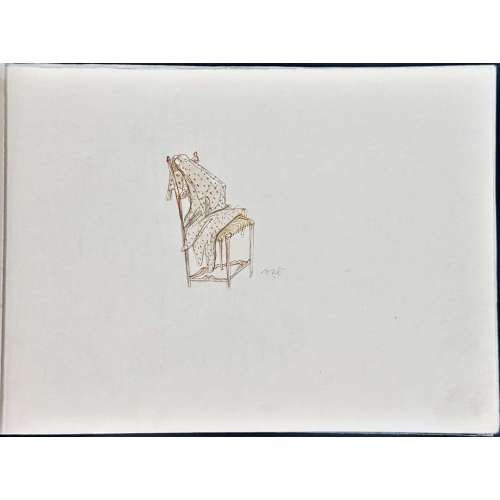 NEWJapanese-style bound oblong horizontal album of 20 colour drawings (watercolour and pencil on paper), 187 x 269 mm, monogrammed on the first page ORS, signed and dated on the last page O. R. SCHATZ | 1954 | x || Artist: Otto Rudolf Schatz (Austrian, 1900 – 1961).
NEWJapanese-style bound oblong horizontal album of 20 colour drawings (watercolour and pencil on paper), 187 x 269 mm, monogrammed on the first page ORS, signed and dated on the last page O. R. SCHATZ | 1954 | x || Artist: Otto Rudolf Schatz (Austrian, 1900 – 1961). -
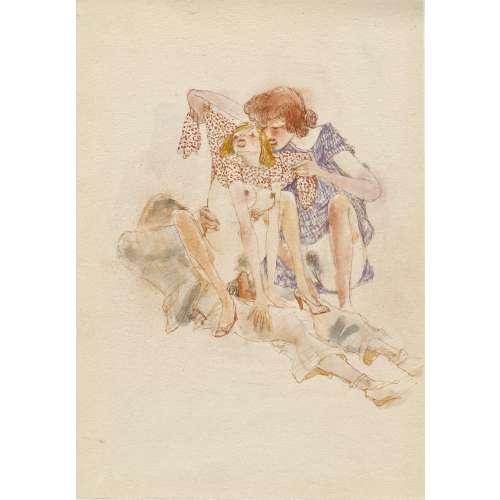 Watercolour on thick wove paper, unsigned. Attributed to Otto Rudolf Schatz (Austrian, 1900 – 1961). Size: 305 x 212 mm.
Watercolour on thick wove paper, unsigned. Attributed to Otto Rudolf Schatz (Austrian, 1900 – 1961). Size: 305 x 212 mm. -
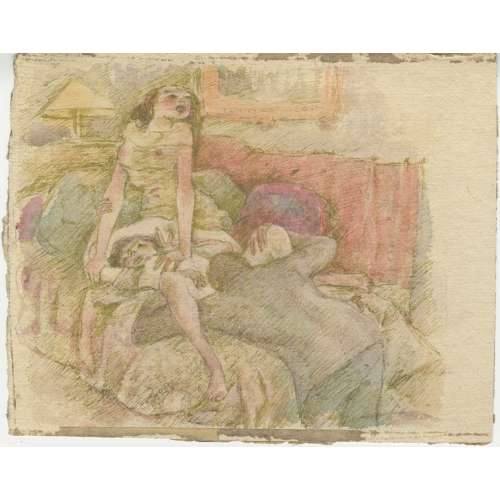 NEWWatercolour, pen and ink on thick wove paper, 180 x 220 mm; to verso: blue ink stamp “PROF O. R. SCHATZ | Wien II, Gr. Mohreng 3b | Tel.: 55 82 566”; fuchsia ink stamp "ARS EROTICA | Hans-J. Döpp"; traces of framing along the margins. Artist: Otto Rudolf Schatz (Austrian, 1900 – 1961).
NEWWatercolour, pen and ink on thick wove paper, 180 x 220 mm; to verso: blue ink stamp “PROF O. R. SCHATZ | Wien II, Gr. Mohreng 3b | Tel.: 55 82 566”; fuchsia ink stamp "ARS EROTICA | Hans-J. Döpp"; traces of framing along the margins. Artist: Otto Rudolf Schatz (Austrian, 1900 – 1961). -
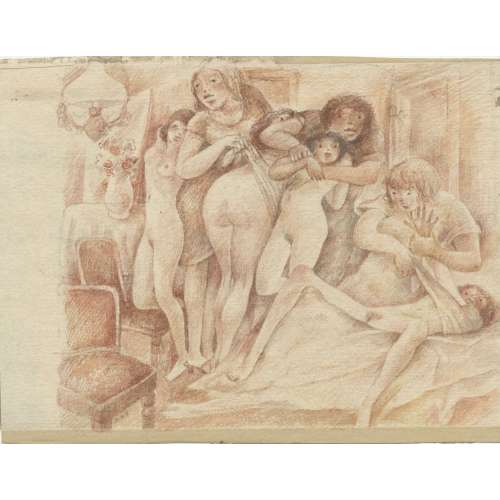 NEWWatercolour, pen and ink on thick wove paper, 177 x 235 mm; to verso: blue ink stamp “Nachlaß O R SCHATZ" and fuchsia ink stamp ARS EROTICA | Hans-J. Döpp; traces of framing along all the margins; traces of framing along the margins; remains of hinges. Artist: Otto Rudolf Schatz (Austrian, 1900 – 1961).
NEWWatercolour, pen and ink on thick wove paper, 177 x 235 mm; to verso: blue ink stamp “Nachlaß O R SCHATZ" and fuchsia ink stamp ARS EROTICA | Hans-J. Döpp; traces of framing along all the margins; traces of framing along the margins; remains of hinges. Artist: Otto Rudolf Schatz (Austrian, 1900 – 1961). -
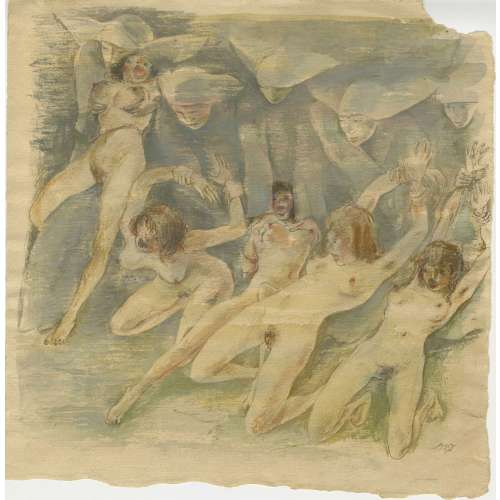 NEWWatercolour, pen and ink wash on thick wove paper, 295 x 298 mm, monogrammed in the bottom right corner "ORSx"; pencil inscription to verso "Um 1950 Otto Rudolf Schatz 3233-03"; two margins cut, traces of mounting on top margin. Untitled. Artist: Otto Rudolf Schatz (Austrian, 1900 – 1961).
NEWWatercolour, pen and ink wash on thick wove paper, 295 x 298 mm, monogrammed in the bottom right corner "ORSx"; pencil inscription to verso "Um 1950 Otto Rudolf Schatz 3233-03"; two margins cut, traces of mounting on top margin. Untitled. Artist: Otto Rudolf Schatz (Austrian, 1900 – 1961). -
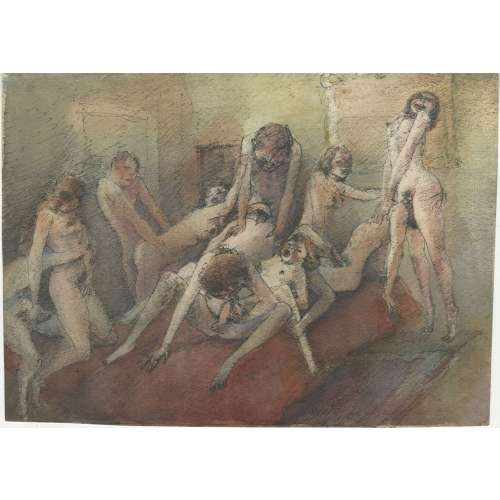 NEWWatercolour, pen and black ink on card stock, 179 x 247 mm; pencil inscription to verso "Otto Rudolf Schatz 3233-03", traces of mounting. Untitled. Artist: Otto Rudolf Schatz (Austrian, 1900 – 1961).
NEWWatercolour, pen and black ink on card stock, 179 x 247 mm; pencil inscription to verso "Otto Rudolf Schatz 3233-03", traces of mounting. Untitled. Artist: Otto Rudolf Schatz (Austrian, 1900 – 1961). -
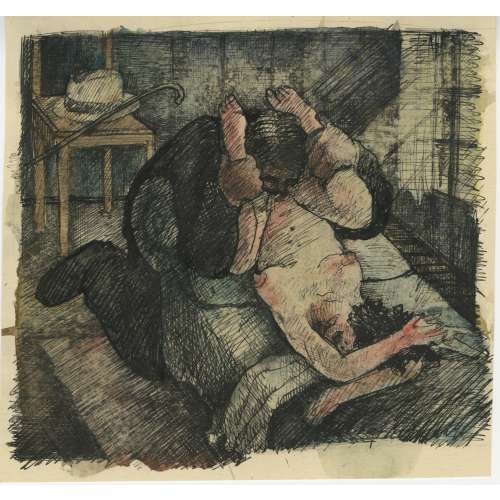 NEWWatercolour, India ink, pen and ink on card stock, 165 x 174 mm; to verso: black ink stamp “Nachlaß O R SCHATZ" and fuchsia ink stamp ARS EROTICA | Hans-J. Döpp; traces of mounting. Untitled. Artist: Otto Rudolf Schatz (Austrian, 1900 – 1961).
NEWWatercolour, India ink, pen and ink on card stock, 165 x 174 mm; to verso: black ink stamp “Nachlaß O R SCHATZ" and fuchsia ink stamp ARS EROTICA | Hans-J. Döpp; traces of mounting. Untitled. Artist: Otto Rudolf Schatz (Austrian, 1900 – 1961). -
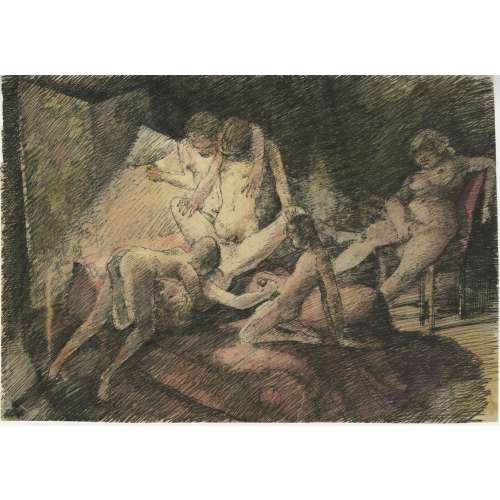 NEWWatercolour, pen and ink on paper, 195 x 282 mm; to verso: black ink stamp “Nachlaß O R SCHATZ" and fuchsia ink stamp ARS EROTICA | Hans-J. Döpp; traces of mounting and repair. Untitled. Artist: Otto Rudolf Schatz (Austrian, 1900 – 1961).
NEWWatercolour, pen and ink on paper, 195 x 282 mm; to verso: black ink stamp “Nachlaß O R SCHATZ" and fuchsia ink stamp ARS EROTICA | Hans-J. Döpp; traces of mounting and repair. Untitled. Artist: Otto Rudolf Schatz (Austrian, 1900 – 1961).


